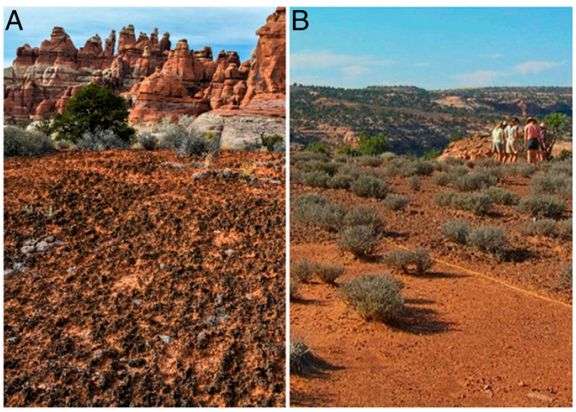September 15, 2015 report
Long term study shows detrimental impact of climate change on drylands

(Phys.org)—A trio of researchers with the U.S. Geological Survey has found that increasing temperatures and changes in precipitation can cause as much havoc in drylands with sparse plant cover as foot trampling by humans or off-road vehicles. In their paper published in Proceedings of the National Academy of Sciences, the team describes their long-term study, what they found and what it could mean for drylands heading into the future.
Drylands, which are land areas not covered with trees or water, make up approximately 40 percent of the Earth's surface, thus trying to understand what will happen to them as the world grows warmer is growing increasingly important. In this latest effort, the researchers focused on one type of dryland—arid areas where groundcover, known as biocrust, keeps the soil from blowing away and also sequesters a lot of carbon. Biocrust is made up of a mix of mosses and lichens and is held together by cyanobacteria. Biocrust, the researchers note, is extremely sensitive to damage from humans, e.g. walking on it, or driving on it with off-road vehicles—small amounts of such traffic can permanently destroy biocrust leaving exposed ground and released carbon. The researchers wanted to know what impact global warming might have on biocrust areas so they set up sections of ground at Utah's Upper Colorado Plateau, as test sites—some area were heated slightly using infrared heaters, others were exposed to more or less than normal precipitation, while others were lightly trampled or lightly driven on by off-road vehicles—all for a period of ten or fifteen years.
At the end of the testing period, the researchers measured the amount of damage, which they defined as loss of biocrust (loss of moss and lichen leaving just cyanobacteria) and found, to their surprise, that it was approximately equal for all of the areas under study—warming the area in the amounts predicated for global warming, or changing rainfall amounts, was just as damaging as allowing people to walk on it or drive off-road vehicles in such areas.
That spells trouble for the future, the researchers warn, because it suggests that rising temperatures will cause the release of carbon from drylands all across the globe, and newly uncovered ground they note, will be extremely susceptible to wind erosion and thus dust storms.
More information: Climate change and physical disturbance cause similar community shifts in biological soil crusts, Scott Ferrenberg, DOI: 10.1073/pnas.1509150112
Abstract
Biological soil crusts (biocrusts)—communities of mosses, lichens, cyanobacteria, and heterotrophs living at the soil surface—are fundamental components of drylands worldwide, and destruction of biocrusts dramatically alters biogeochemical processes, hydrology, surface energy balance, and vegetation cover. Although there has been long-standing concern over impacts of physical disturbances on biocrusts (e.g., trampling by livestock, damage from vehicles), there is increasing concern over the potential for climate change to alter biocrust community structure. Using long-term data from the Colorado Plateau, we examined the effects of 10 y of experimental warming and altered precipitation (in full-factorial design) on biocrust communities and compared the effects of altered climate with those of long-term physical disturbance (>10 y of replicated human trampling). Surprisingly, altered climate and physical disturbance treatments had similar effects on biocrust community structure. Warming, altered precipitation frequency [an increase of small (1.2 mm) summer rainfall events], and physical disturbance from trampling all promoted early successional community states marked by dramatic declines in moss cover and increases in cyanobacteria cover, with more variable effects on lichens. Although the pace of community change varied significantly among treatments, our results suggest that multiple aspects of climate change will affect biocrusts to the same degree as physical disturbance. This is particularly disconcerting in the context of warming, as temperatures for drylands are projected to increase beyond those imposed as treatments in our study.
Journal information: Proceedings of the National Academy of Sciences
© 2015 Phys.org




















